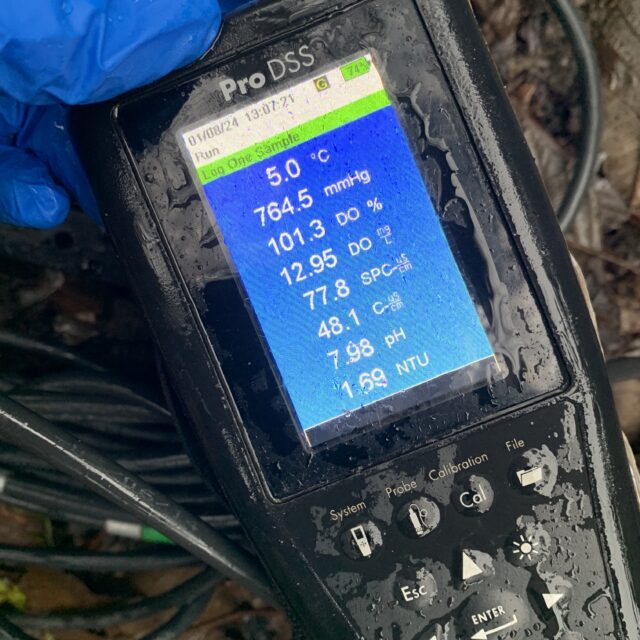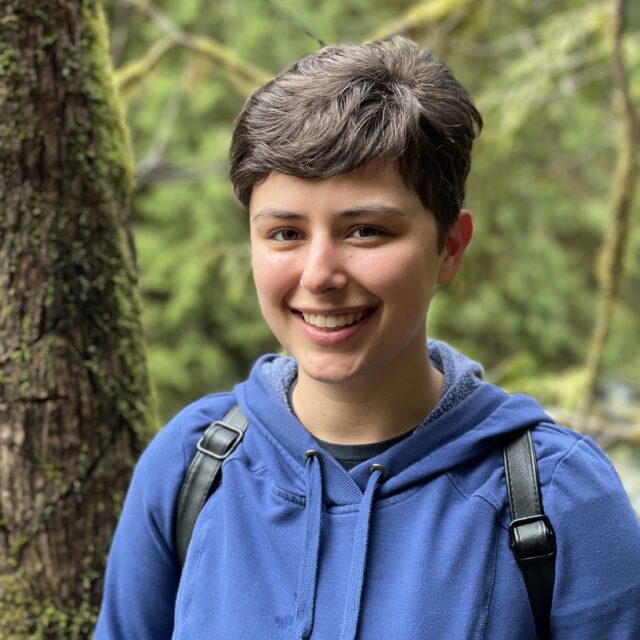Nikki VandePutte, the field lead for the Redmond Paired Watershed Study, takes us through a typical day of stormwater testing in the Seattle area, shedding light on the challenges and importance of her work.
Date and Location:
- 6:30-10:30 AM, January 24th, 2024, Redmond Paired Watershed
Weather Conditions:
- Cold and Rainy
As team lead, Nikki is responsible for catching storm events. When a large weather event occurs (over 0.25 inches of rain), she must quickly coordinate with her team to quickly mobilize her field team. Planning can be very tricky as the weather is often unpredictable.
On January 24th, Nikki and her team met at the Redmond Paired Watershed at 6:30 AM. At the meeting spot, they distributed gear and prepared the action plan. Equipped with a Herrera vehicle, Nikki ensured all necessary gear was packed, including personal protective equipment (PPE) and sample bottles (labeled and organized in bags by site). Stormwater testing fieldwork often involves walks through wooded trails, sometimes taking up to an hour round-trip, and navigating steep slopes, which is especially challenging in the dark. Safety measures include a buddy system, using flashlights, and wearing high-visibility clothing.
 The team split into two teams of two, covering 12 sites in total. The sampling process involves using various bottles designed for different measurements.
The team split into two teams of two, covering 12 sites in total. The sampling process involves using various bottles designed for different measurements.
Parameters that are tested:
- Total suspended solids
- Turbidity
- Hardness
- Dissolved Organic Carbon
- Total Phosphorus
- Total Nitrogen
- Total & Dissolved copper
- Total & Dissolved zinc
- Fecal Coliform
- 6PPD-q
- PAHs
The team also conducted on-site measurements, putting a water quality meter directly into the creek for temperature, conductivity, and dissolved oxygen readings.
Once the samples are collected, they are put in coolers with ice until they arrive at the lab in Redmond. After processing, Nikki reviews the lab results for quality assurance. If any discrepancies with the data arise, Nikki reaches out to the sampler; they review photos and notes from the site visit.
About the project: Nikki emphasizes the importance of stormwater testing in informing stormwater management activities. The Redmond Paired Watershed Study aims to quantify improvements resulting from rehabilitation efforts, comparing different watershed basins. The study asks the question: "How effective are watershed rehabilitation efforts at improving receiving water conditions at the watershed scale?" To uncover this, the City of Redmond is focusing on stormwater best management practices (BMPs) in a subset of priority watersheds that are moderately impacted by urbanization and therefore expected to respond more quickly to rehabilitation efforts.

There are 12 sites, composed of 6 creeks. Watersheds in the study include:
- Two watersheds that are moderately impacted by urbanization and prioritized for rehabilitation efforts, Tyler’s Creek and Country Creek.
- Two watersheds with relatively pristine streams that do not require rehabilitation, Seidel Creek and Collins Creek.
- Two watersheds that are significantly impacted by urbanization and not currently prioritized for rehabilitation, Monticello Creek and Tosh Creek.
Nikki's day in the life of a stormwater tester displays the dedication and challenges to understanding and mitigating the impact of human activities on our waterways. This work contributes significantly to environmental conservation and sustainability, paving the way for healthier waterways and habitats.
To learn more about this kind of field work, check out Shawree’s experience collecting stormwater here.
